The advancement in the manufacturing of dental surgical instruments helps the dentist with atraumatic and precise tooth extraction.
In dentistry, dental extraction forceps are used with an elevator to extract the teeth.
Due to modern dentistry instruments and methods, there are many options available for a smooth and delicate extraction process compared to one decade before.
Every dentist clinic must have extraction forceps because they are the most essential instruments in dentistry. Furthermore, there is a wide variety of these dental forceps available.
This blog provides a brief guide to different types of dental extraction forceps, depending on their features, uses, and benefits.
Extraction Dental Forceps Types and Uses
There are five different types of dental extraction forceps available for various procedures and patient care needs.
All these extraction forceps have some unique features that distinguish them from each other.
The following is the list of various types of dental extraction forceps:
- Root Fragment Forceps
- English Forceps
- American Forceps
- Atraumatic Forceps
- Modified Dental Extraction Forceps
All these types of forceps dental have a lot of variations depending on sizes and functions.
Let's explore in detail the functions and features of each one.
1. Root Fragment Forceps
Root fragment forceps are specialized forceps dental instruments that allow the easy removal of a significant part of the tooth root from the alveolar bone after tooth extraction.
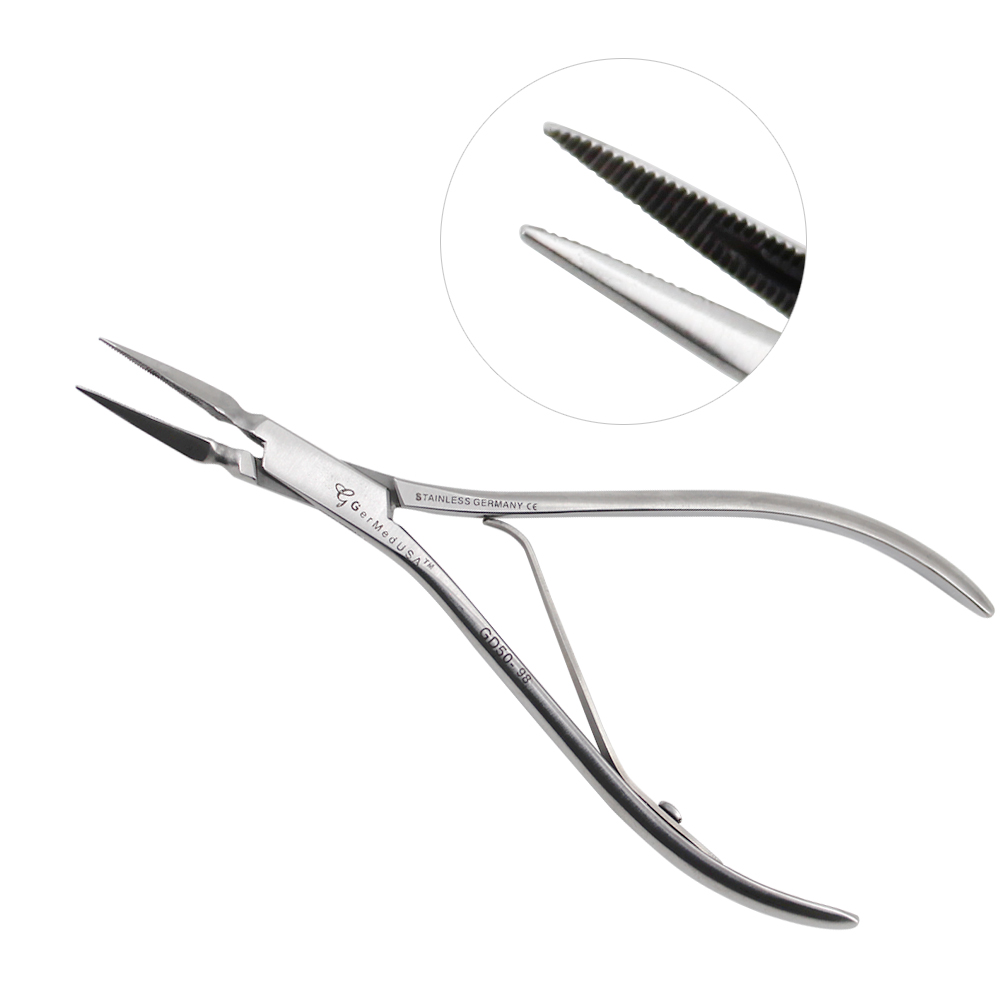
Long, slender beaks of root extraction forceps are utilized when extracting delicate and deep sockets.
Key Features and Functions
Here are the general features and functions of this unique dental extractor:
- Slender design helps minimize trauma to surrounding tissues.
- Serrated jaws help a firm grip on the root for smooth extraction.
- Extra long beaks of these forceps help reach deep into the socket.
The primary function of these types of forceps dental is to grasp and remove the residual tooth root from the alveolar bone.
Available Variations
These types of dental extraction forceps are available on GerDentUSA.
We manufacture these forceps from German stainless steel material in three different variations, including:
- Dental Root Extraction Peets Forceps 4 3/4"
- Root Fragment Forceps, Straight, 14.5cm
- Root Fragment Forceps, 45°, 14.5cm
2. English Forceps
English forceps are specialized dental surgical instruments designed to remove the interior teeth (incisors and canines) and the posterior teeth (molar and premolar).
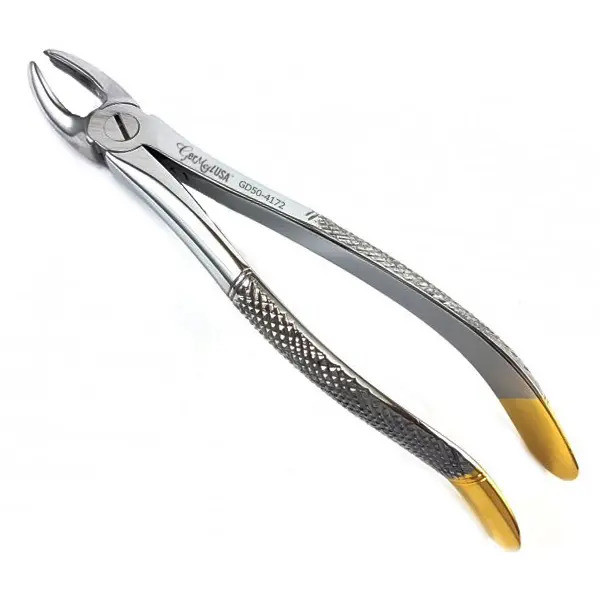
They can also be used to remove roots in different cases.
Key Features and Available Patterns
Here are some features of these types of dental extraction forceps:
- Serrated jaws
- Curved and straight designs
- Narrow profile of the beaks
- The extended length of its beaks helps in-depth reach
On our site, these are available in multiple variations, tailored to meet different procedural needs, mainly such as:
- English Extraction Forceps, Lower Molars, MD-4
- English Extraction Forceps, Lower Wisdoms, Right, 22R
- English Extraction Forceps, Lower Wisdoms, Left, No. 22L
- English Extraction Forceps, Upper Wisdom, Universal, Parallel Beaks, MD-1
3. American Forceps
These dental extraction forceps are specially designed to extract maxillary incisors and canines. They are primarily used on longer and stubborn teeth.
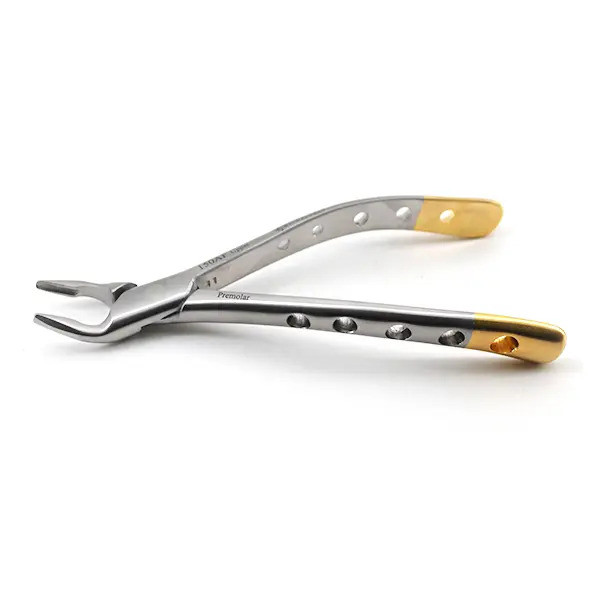
The wider beak of American forceps provides a firmer grip on the tooth, especially posterior teeth.
Key Features and Available Patterns
Below are the unique and distinct features of American forceps:
- Broader jaws
- Manufactured from sturdy material to endure force for effective extraction
- The adaptive handle offers comfort and easy grip for dentists during surgery
GerDentUSA provides multiple variations of these forceps to help dental professionals in various cases.
Some of them include:
- American Extraction Forceps, Lower Universal
- Albrecht American Extraction Tweezer 16cm, Pointed
- American Extraction Tweezer, Albrecht, 16cm, Round
- American Extraction Tweezer, Albrecht, 16cm, Pointed
American Vs. English Forceps
American and English forceps are types of dental extraction forceps that are mainly used for tooth extraction, but a particular characteristic difference makes them suitable for different procedures.
Table: Key Differences between American and English Forceps
|
Features |
American Extraction Forceps |
English Extraction Forceps |
|
Beaks |
Wider and more robust |
Slender and narrow |
|
Grip |
Stronger grip |
Slender and narrower |
|
Sustainability |
Typically used for larger |
Often used for smaller anterior teeth |
|
Construction |
Generally, more sturdy |
Often more slender |
When to Use
American Extraction Forceps
These are ideal for larger, more stubborn teeth, especially in the posterior region (premolars and molars).
They provide a strong grip and are suitable for complex extractions.
English Extraction Forceps
They are well-suited for smaller anterior teeth (incisors and canines).
Their slender design and delicate grip make them suitable for more precise manipulations.
These are the best dental forceps according to different procedure needs and patient comfort.
4. Atraumatic Extraction Forceps
Atraumatic extraction forceps prevent the risk of trauma on the surrounding tissues during tooth extractions.
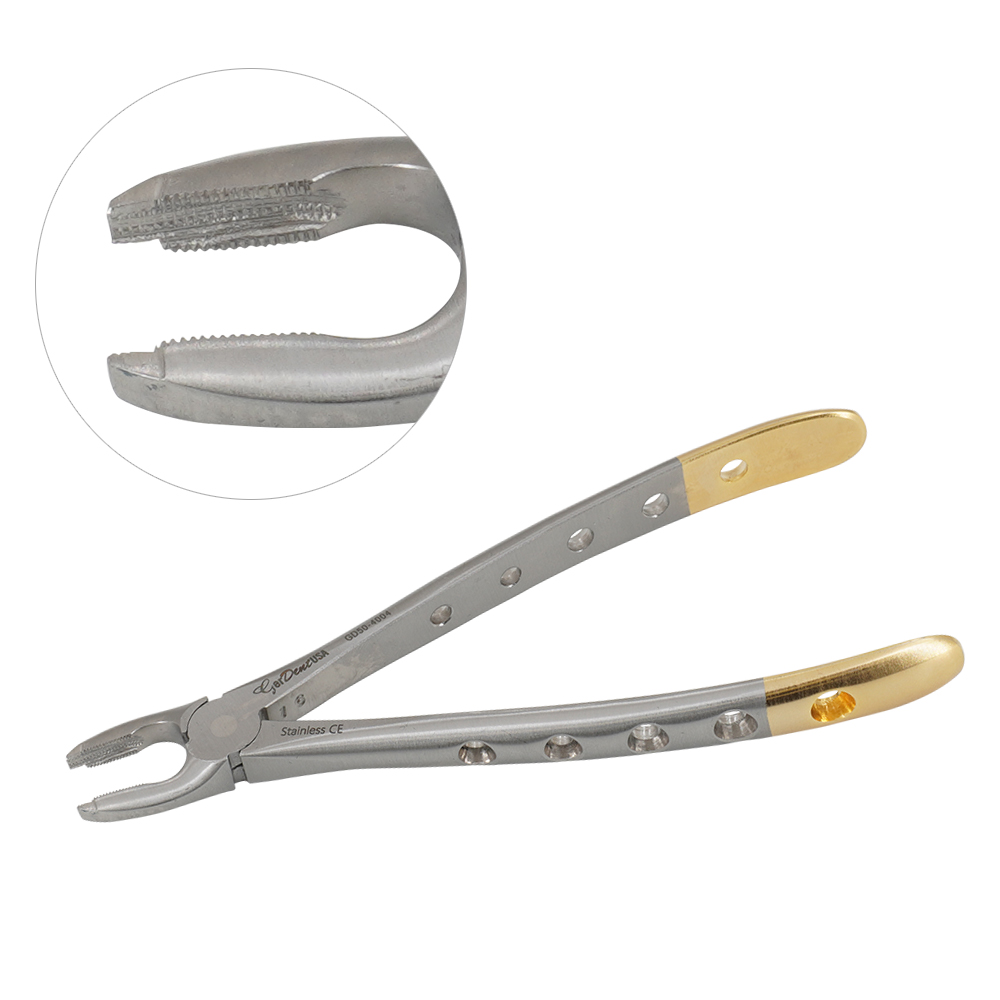
They have a specific feature that protects the alveolar bone, adjacent teeth, and soft tissue from sustaining any damage.
Key Features:
- The serrated jaws secure the tooth.
- Rounded or blunt tips to reduce the risk of fracturing.
- The handles are designed to allow precise control during extraction.
- Some atraumatic extraction forceps may have specialized designs, such as:
- Angled beaks
- Additional features to accommodate specific tooth anatomies or extraction challenges.
Key Benefits:
- Reduced trauma and help in comfortable and painless procedures for patients.
- Help to preserve the contour of the jawline and improve aesthetic outcomes
- Minimum damage to the alveolar bones and soft tissues.
Nine different patterns are available to meet the various needs of the procedure.
Some of them include:
- Atraumatic Lower Root Forceps Extra Long Beak 46XL
- Atraumatic Forceps Upper Long Beak 51XL
- Atraumatic Upper Universal Forceps 1
- Atraumatic Lower Molar Forceps 7C
- Atraumatic Upper Molar Forceps 6
5. Modified Dental Extraction Forceps
Angled or specialty beaks of modified extraction forceps often used to extract third molars or posterior teeth in patients with limited mouth opening (trismus).
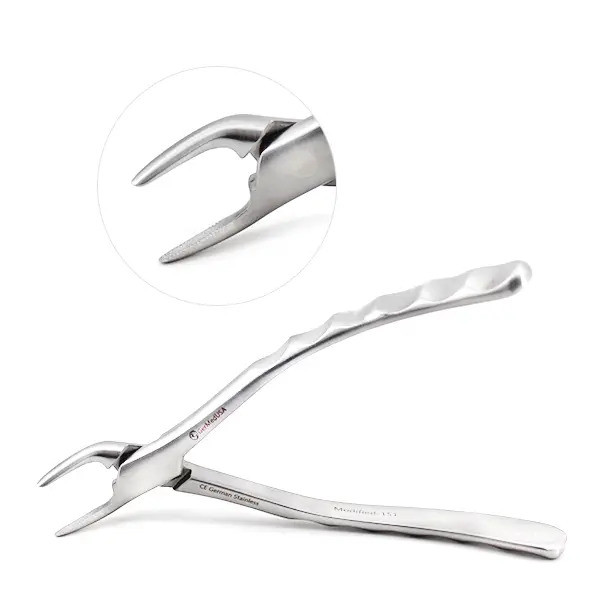
Key Features and Benefits:
- The angled beaks can help access teeth that are difficult to reach due to limited mouth opening or anatomic variations.
- Some modified forceps may have specialized tips (minimize trauma), such as:
- Rounded tips
- Blunt tips
- Depending on the specific design and the patient's anatomy, these can extract teeth in both the upper and lower jaws.
- Made from German stainless steel material.
- Long-lasting and reliable.
Seven modified dental extraction forceps are available to meet various procedure patterns to ensure a safe and effective extraction.
Some of these include:
- Modified Lower Universal Forceps
- Bird Big Forceps
- Mini Bird Big Forceps
- Modified Forceps Cowhorn
How To Use Extraction Forceps for Better Outcomes
The best practices approach in using dental extraction forceps ensures a successful removal of the tooth. Types of dental extraction forceps are designed to meet different procedural needs. So, let’s look at how we can use it for better outcomes.
1. Selection of the Right Forceps
In general, we can say that there are anterior and posterior forceps, and the choice should also depend on the tooth's condition.
For example, we use traumatic forces in gentle forceps extractions, and root fragment forces are used to remove residual tooth roots.
2. Positioning
Position the tool correctly on the tooth or root to get a good grip with the specific forceps.
The beak shape allows American Forceps to grip molars teeth securely, while English Forceps are best for incisors or canines.
3. Controlled Movement
Be very gentle during luxation or rotation; a constant, slow pressure should be used to prevent harm to the surrounding tissues.
To isolate root fragments, use Root Fragment Forceps with serrated jaws to provide secure gripping without undue force.
4. Patient Comfort
The patient’s comfort should also be considered during the extraction.
Do not use uncomfortable forceps for the dental arch and forceps that result in much pain and slow recovery time.
Not-To-Do Things During the Procedure
1. Avoid Excessive Force
Exerting excessive force is a significant problem that might affect the surrounding bone and tissues, such as causing a fracture of the alveolar bone.
This is particularly important in the case of Atraumatic Forceps, which are among the least invasive.
2. Do Not Use the Wrong Forceps
Choosing the wrong forceps for exodontia will result in ineffective and injurious extractions.
For instance, American Forceps may be ineffective in working on delicate anterior teeth because they are designed for larger teeth.
3. Do Not Ignore Proper Sterilization
Dental extraction forceps must be cleaned after every use and before the subsequent use to prevent the spread of infection.
4. Avoid Rushed Movements
Do not rush the process; always take your time when doing the extraction.
Sudden and jerky movements risk damaging the soft tissues and the alveolar bone, especially when attempting to extract challenging molars with Modified Dental Extraction Forceps.
Conclusion
Modern dentistry uses different types of dental extraction forceps, which are distinguished depending on their purpose, versatility, and patient comfort.
Dentists should ensure they possess suitable forceps to attain the most optimal outcomes with minor side effects.
For any practice that offers the best care, including these forceps dental instruments is essential.
At GerDentUSA, we aim to deliver quality dental instruments to dental practices.
We also provide the best dental forceps that are accurate, user-friendly, and long-lasting. Our quality services and attractive prices ensure you get the best value on your investment.
Ready to enhance your dental practice with top-quality dental forceps? Explore different options now!
FAQs
Which tools are used in tooth extraction?
Dentists use forceps to grab and leverage the tooth roots, while elevators loosen and detach the tooth from the bone. Chisels break up bone or remove fractured root fragments, while probes identify affected teeth and residual roots. Curettes remove dirt and smooth socket edges after extraction.
How do you use the extraction forceps?
First, the dentist squeezes the handles, and then the socket emerges. These forceps are used to apply controlled pressure to the division point of the decayed lower molars. Use these forceps carefully since they can produce strong forces that might break the alveolar bone.

